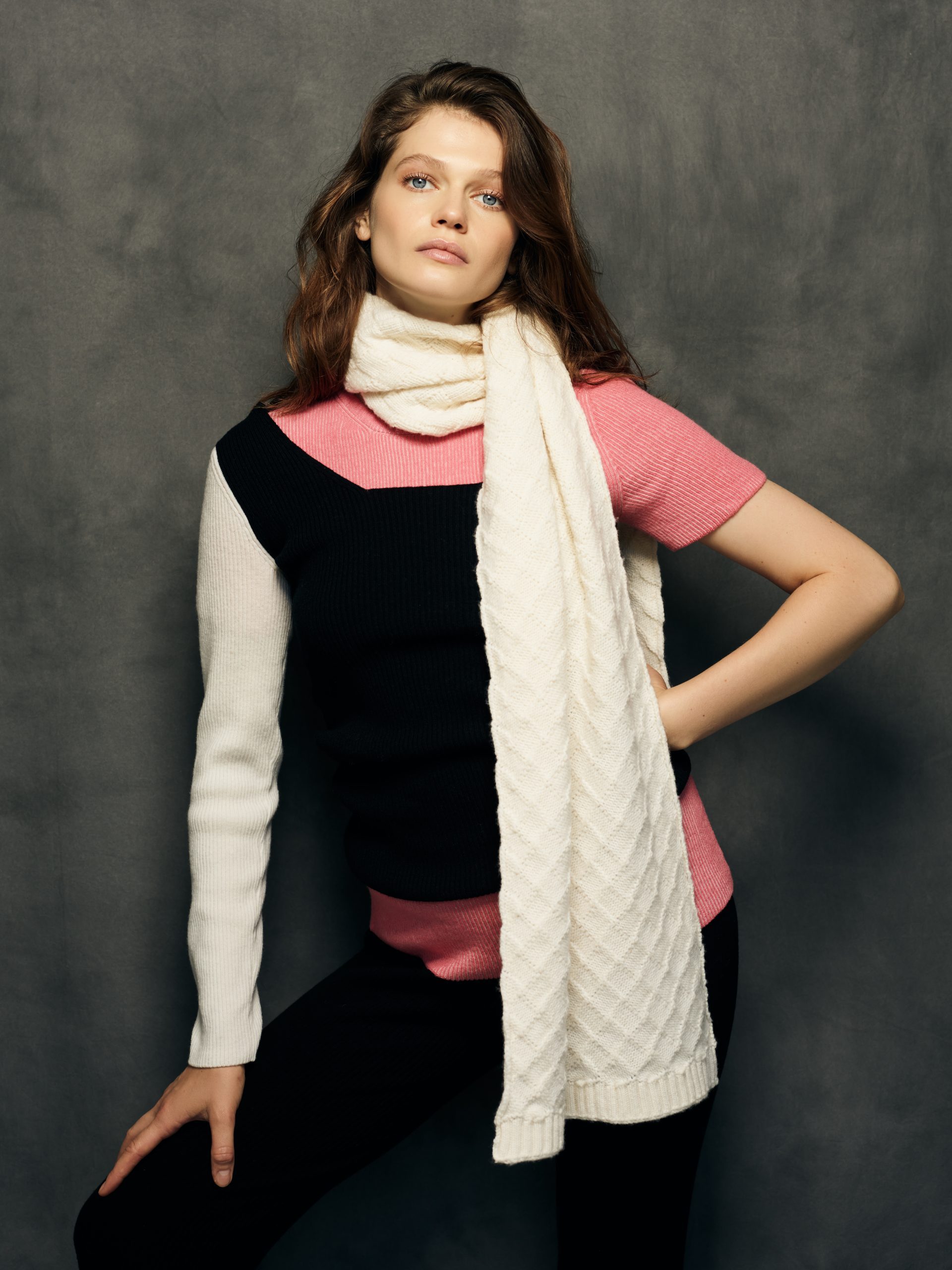It takes the annual cashmere wool from 4 to 6 goats to produce the yarn needed for knitting a thin cashmere jumper.
Given the rarity of this exceptional yarn, we consider that both we as producers and you as customer have to work together to ensure your cashmere cuddle has a long life in optimum condition, allowing you to collect a lot of carefree memories wearing it.
As most of you know, cashmere is a rare wool obtained from the cashmere goats. To put its rarity in perspective, we can consider that the global annual production of cashmere is around 6500 metric tons, while the wool production is over 2 million tons per year, and the annual cotton production is over 22 million tons.
Our care for your cashmere jumper, (cashmere cuddle as we like to call it) starts before we produce it. While we are not involved directly in this part of the process, we ensure that we choose yarn manufacturers that are global leaders in this field, have sustainable policies for the use of chemicals, respect the environment and provide a safe working environment for their employees.
We use cashmere from several highly reputed Italian spinners that have a long tradition of being at the forefront of the developments in their field.
The knitted product is washed, dried and ironed with care, based on discussions with the spinners, to make sure we provide a finished product that does justice to the yarn used.
We do not produce the cashmere jumpers in large quantities or many months in advance. The limited production is released immediately when ready, and our operations office is located in the same neighbour hood as the factory, ensuring that your items are not stored in warehouses, or shipping containers, but shipped to you in an ideal condition, ready to be used.
Once you receive your Cashmere Cuddle, use your AmiAmalia cashmere care tools
We provide every Cashmere Cuddle with a dust bag made from cotton, ideal for storing your jumper while travelling, or when you want to keep your jumper in your handbag.
Caring for your Cashmere Cuddle
No perfume
Do not allow perfume to get in direct contact with your jumper, as it may stain it.
Air
Let it air. While cashmere loves water and washing it will make it softer and softer, I personally try to avoid unnecessary washing, as I like the initial look of the fiber. Hanging the jumper on the balcony, terrace (not in direct sunlight) is an easy way of refreshing your garment.
Fiber rest
Let it rest after each wear, give the fiber time to relax, to return to its initial shape. Wearing the same cashmere jumpers few days in a row is not recommended.
Garment steamer
If it has creases, a garment steamer is a perfect tool to give your cashmere jumper an impeccable look. You don´t need to have a professional garment steamer, the small, travel-style ones will do the job as well.
Remove stains
Stains though put most of our care advise on hold. (Not only on our cashmere cuddles, but on your clothes in general). Actually, a stain on your cashmere jumper should be a HOLD button for whatever you are doing J, as the chances of removing a fresh stain are a lot bigger than trying to work magic on a dry, old stain.
Stains have to be worked out locally. Depending of what caused the stains, there are various ways of taking care of it, some will disappear with just a bit of tepid water (please do not use hot water on a cashmere jumper, or it will felt), other may need a stain removing solution.
Soap & Dry Cleaning
Gale soap is a great, natural tool for removing stains, we usually use a small quantity of liquid or solid gale soap directly on the stain, lather it in, let it work for few minutes, rinse, and repeat until the stain is gone. Washing and letting the jumper dry without the stain being removed it will seal the stain in the fiber.
Dry cleaning is also a good stain removing alternative. Do not store your jumpers with stains on them.
Detergent
Use only ecological, natural, lanolin free, liquid detergents especially made for the wash of wool and silk. We have used Ecover Delicates for Wool and Silk for many years, it is a safe detergent to use, and we are sure there are similar detergents in your area as well.
Pour a bit of detergent in tepid water, mix it well, and put your jumper in. I prefer to turn the jumper inside out. Make sure it is fully immersed, you can gently push it under the water if necessary. Let it stay there for few minutes, depending on how dirty it is, 10 minutes should be enough in any case. Rinse it gently, and be careful with the water temperature.
I usually remove excess water by rolling the jumper in a towel, but I also know a lot of people are very happy with the results of using a salad spinning drainer (remove salad first).
Know your washing machine
While some washing machines have an excellent hand washing program, we don’t recommend your exclusive cashmere jumper to be the first item to try this function on.
Washing
The cashmere fiber loves water, and a careful wash will make your jumper bloom. But there are few rules to observe for a successful cashmere wash:
Drying it
Re-shape your jumper on a flat surface, like a towel, and lay flat to dry. Avoid prolonged direct sunlight or placing the jumper close to a direct source of heat.
Cashmere jumpers do not dry fast, so don´t worry if it takes some time
Ironing it
I always iron my favorite clothes items with caution, using a tea towel over it, and with steam. I find that the garment steamers are great for removing regular creases from the cashmere jumpers. As a travel tip, if you don’t have an iron or a steamer around you, leaving your jumper on a hanger on a bathroom door, for example while you take a hot shower, also helps, the steam will have a similar effect.
The rule about not allowing hot water to be in contact with your jumper is still valid, is just the steam you are after.
Repairing a pull or a hole
Pulls or holes are definitely not the end of your jumper, these are normal occurrences that bring character to your garment, so don´t panic. They can be fixed.
Some people are just handy and can work magic on repairing their own clothes, and others (like myself) would just cause a bigger damage.
The best way to fix this is to stop by the closest tailor or clothes repair shop and ask someone to do it. If you are a fast learner, there is an abundance of tutorials on the web that can be very helpful.
If you cannot find someone in your vicinity, you can always send it to us and we will have a professional take care of it.
We do not provide each jumper with spare yarn for repair, because we know in 99% of the cases those gets misplaced, thrown away, and is just a waste of resources in the end. We do have yarn remains in our operations center, so if you need a specific yarn to fix your jumper, send us an email and will send you some.
Removing pilling
Pilling is a normal occurrence in a cashmere jumper. Depending on how tightly your jumper is knitted, and how you use it, some will pill faster, some slower, but pilling is to be expected. The good news is that removing pilling is very easy and will not affect the look of your jumper.
We are providing a complementary AmiAmalia cedar wood cashmere comb with each of our Cashmere Cuddles to make things easier, and we don’t recommend the use of household tools, like razors or Velcro stripes, etc.
If is the first time you use a cashmere comb, is probably easier to watch a quick tutorial on the web.
Upcycling and reclaiming
Transforming a pre-loved jumper in a jumper for children, a small décor pillow, a toy, is getting easier and easier. The internet and the social media are a great platform for creative businesses to connect with potential customers and we will endeavor to shortly have a list of small businesses that we recommend for-transforming your well-loved cashmere jumper into another beautiful object. We do hope that it will be years and years before your jumper will need such upcycling though.






